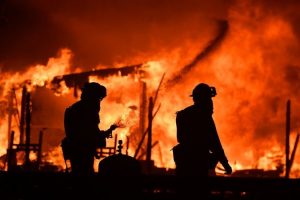 Over 40 people have been killed in the California fires. All but one, so far, have been residents; only one fire-fighter has died in a vehicle-related incident. But the risk to firefighters who throw themselves in danger to protect people and property in California and elsewhere is clear. We’ve seen far too many cases of firefighters being consumed by the blazes they’re fighting recently (as the new movie “Only the Brave” tragically illustrates).
Over 40 people have been killed in the California fires. All but one, so far, have been residents; only one fire-fighter has died in a vehicle-related incident. But the risk to firefighters who throw themselves in danger to protect people and property in California and elsewhere is clear. We’ve seen far too many cases of firefighters being consumed by the blazes they’re fighting recently (as the new movie “Only the Brave” tragically illustrates).
But the hazards of the fires in California don’t stop with the people caught in their path.
Where There’s Fire, There’s Smoke
CalOSHA just released special guidance for employers to help them protect employees in the area of the fires from the hazards of smoke.
Smoke from wildfires contains chemicals, gases and fine particles that can harm health. The greatest hazard comes from breathing fine particles, which can reduce lung function, worsen asthma and other existing heart and lung conditions, and cause coughing, wheezing and difficulty breathing.
CalOSHA recommends, if possible, engineering controls for those working inside (using a filtered ventilation system) or administrative controls for those working outside (like limiting the time that employees work outdoors.)
And, of course, respirators approved by NIOSH and labeled N-95, N-99, N-100, R-95, P-95, P-99, or P-100 for employees working in outdoor locations designated by local air quality management districts as “Very Unhealthy,” “Unhealthy” or “Hazardous.”
And because respirators are difficult to breathe through and put a burden on the lungs, workers wearing respirators should take frequent breaks and go to a clean area, remove the respirator and seek medical attention if they feel dizzy, faint or nauseous.
Ashes to Ashes
Meanwhile, the New York Times had an interesting article about the hazards contained in the ash that residents and recovery workers may be exposed to. Dr. Karen Relucio, the Chief public health officer in Napa County, was horrified when she heard of people digging through the ashes of their burned down houses for any surviving items.
“Just think of all the hazardous materials in your house,” she said in an interview. “Your chemicals, your pesticides, propane, gasoline, plastic and paint — it all burns down into the ash. It concentrates in the ash, and it’s toxic,” said Dr. Relucio, who declared a public emergency over the hazardous waste from the fires, as have at least two other counties.
In fact, the problem in California is so massive and so unprecedented that Alan Lockwood, a retired neurologist who has written widely about public health, thought “an apt comparison might be the environmental cleanup after the terrorist attacks of Sept. 11, 2001, in New York, as debris and dust swirled through Lower Manhattan.”
Why is the ash so hazardous?
Household building materials are obviously different from the components of a concrete tower. But they pose risks too. Treated wood in a house’s frame, for instance, put there to prevent bacteria growth, can contain copper, chromium and arsenic. Consumer electronics contain metals like lead, mercury and cadmium. Older homes might have asbestos shingles. Even galvanized nails are a concern because when they melt they release zinc. All are potentially harmful.
“It’s a completely complex mixed bag of different stuff that’s there,” said Geoffrey S. Plumlee, associate director for environmental health with the United States Geological Survey.
Dr. Plumlee led a study after several Southern California wildfires in 2007 that found that ash from burned-out residential areas contained elevated levels of arsenic, antimony and metals including lead, copper and chromium. In most cases the levels were above federal Environmental Protection Agency guidelines for soil remediation.
So who’s going to do the cleanup? What protections will they need? What government agencies will be responsible? What laws will protect the workers — and the citizens — who are exposed to the ash?
While the fires are still burning, no one has really addressed these questions. But with more than 7,000 structures burned to the ground the problems of protecting citizens and recovery workers — and the environment — will be huge, and Californians will have to deal with them for many months or years to come.
AIHA has a Wild Fire Smoke damage Technical Group who are about to publish a White Paper on the subject. They are trying to get on the speaking roster for the 2018 AIHCE in Philadelphia.
Jordan; what is the state of the water table in north and south California ? Is it still being massively depleted? What are the construction codes doing to protect people and property in the counties affected by the burning ? Isn’t it time to stop building with wood in fire prone areas ?